Bare spots are often caused by inadequate growing conditions or by runoff washing away topsoil. In either case, once the protective vegetative cover is gone, erosion occurs at a faster pace. If erosion continues unabated, gullies may begin to form that will deepen and widen over time.
There are two general approaches for combating erosion in your yard. The best solutions will often use both:
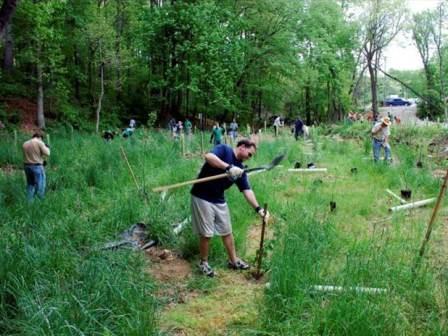 Protect Eroded Land: Vegetation, Mulch, Gravel, Terraces, Check Dams »
Protect Eroded Land: Vegetation, Mulch, Gravel, Terraces, Check Dams »
Taking these steps will help protect the eroded area and restore the land.
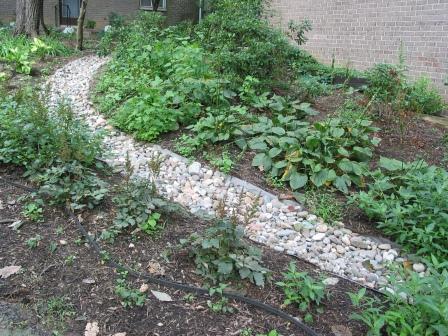 Redirect Runoff Around the Eroded Land or Capture Flow »
Redirect Runoff Around the Eroded Land or Capture Flow »
Redirecting and capturing runoff will prevent the erosion damage from getting worse.
How to Protect Eroded Land
There are several protection strategies for recovering eroded land. For areas with light erosion problems, replanting with vegetation and covering with mulch are good solutions. For erosion along footpaths, covering with mulch or stone is the best option. For heavy erosion in areas of concentrated flow, the most effective solutions are check dams or terraces.
1. Replant Vegetation Suited to Site Conditions
 Well-established vegetation can stabilize the soil in cases of light erosion. When you replant the area, make sure to choose plants that are adapted to the conditions of the site, both in terms of moisture and sun or shade levels. If the plants cannot take root and spread, your erosion problems will not be solved. On slopes with a grade that exceeds 3:1, a non-grass low-maintenance vegetation should be considered to avoid mowing difficulties.
Well-established vegetation can stabilize the soil in cases of light erosion. When you replant the area, make sure to choose plants that are adapted to the conditions of the site, both in terms of moisture and sun or shade levels. If the plants cannot take root and spread, your erosion problems will not be solved. On slopes with a grade that exceeds 3:1, a non-grass low-maintenance vegetation should be considered to avoid mowing difficulties.
Before replanting, fill soil with high clay content may be needed to fill in areas undergoing gully erosion. To fill in the gully, use the same method that is used to fill in sinkholes, followed by a layer of topsoil spread over the surface. Once your site is ready for planting, you may need to install a temporary diversion to redirect runoff until the groundcover can be established.
- Mulch or compost can be used in tree and shrub beds or in areas where vegetation is difficult to grow.
- Plants for erosion control. From groundcover to shrubs, these hardy native species can thrive in tough conditions. See the plant list.
- Soil fertility or pH sometimes needs improvement to grow appropriate vegetation. Learn how to do a soil test and decide whether you need a change in pH or nutrient level.
- Mixing compost into the soil can also help soil fertility. Learn about adding soil amendment or a compost blanket.
- Tips for sodding: If sod is used, make sure the final elevation does not cause water to collect on the up-slope side. Prepare the soil with a rake. Place sod strips perpendicular to the flow of water and use sod staples to keep them in place.
- Tips for seeding: If grass seeds are used, consider protecting the seeds with a thin layer of topsoil (approximately ¼ of an inch) followed by a thin layer of straw. This thin layer of soil and straw will help protect the seeds from birds and also enhance germination. Watering in the first year will help the grass get established.
2. Footpaths with Exposed Soil: Cover with Mulch or Gravel
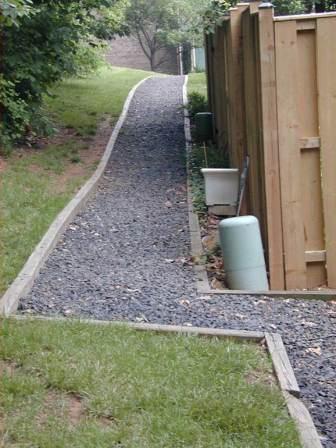 For areas with heavy foot traffic, stepping stones or a gravel or mulch path can be used to cover and protect eroded areas. Vegetation can be used to line the borders of these high-traffic areas. A layer of mulch or compost also can be used in tree and shrub beds or in areas where vegetation is difficult to grow.
For areas with heavy foot traffic, stepping stones or a gravel or mulch path can be used to cover and protect eroded areas. Vegetation can be used to line the borders of these high-traffic areas. A layer of mulch or compost also can be used in tree and shrub beds or in areas where vegetation is difficult to grow.
Tips for installing stepping stones:
- First loosen the compacted area with a rake, a sturdy pitchfork or an aerator, if you wish to grow grass around the stepping stones when finished.
- Put in a layer of sand or small gravel to keep the stepping stones in place.
- Position your stepping stones at reasonable distances to provide easy stepping for the average user.
- Seed with grass seeds or any other appropriate vegetation of your choice, or add mulch or gravel around the stones.
Tips for installing a gravel or mulch path:
- Mark off the area that you will include in your path using landscaping spray paint, temporary flags, or other visual markers. The width of the path should be based on site conditions and personal preference.
- Remove any vegetation and, if necessary, grade the area so that it drains in the preferred direction.
- Cover the length of exposed soil with landscape fabric. This will keep weeds from growing through the final layer of cover material, and also to keep the cover material from sinking into the soil over time.
- Install landscape edging (see picture for example) along the length of the path. Create a gap in the edging in any low spots to allow water to flow out and to prevent ponding within the path. Instead of using edging, you may choose to tuck the ends of the fabric into the soil along the length of the path.
- Spread a cover material such as pea gravel, bluestone or mulch within the limits of the markers.
3. Terraces
For steep slopes, consider building terraces along the contour of the slope (intersecting the flow path).
- Shorter terraces in series are more effective than higher terraces.
- A variety of landscaping materials including coir fiber biologs, stone or wood can be used to create terraces.
- It is important to have a good drainage system (gravel or gravel with perforated pipes) installed behind your terrace retaining wall.
- Please note that 3:1 or steeper slopes may call for the use of tiered walls, which requires professional engineering and a building permit. Terraces taller than two feet may require a County permit. Please see: Building Permits - Retaining Walls.
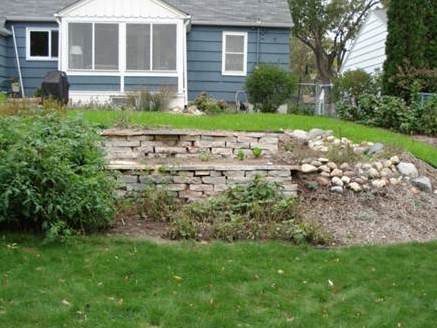
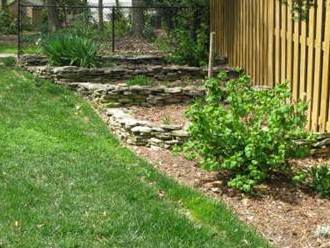
4. Build Check Dams
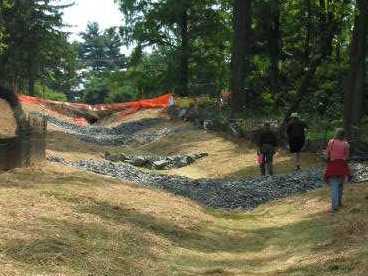 If erosion is occurring within an existing swale, channel, or a narrow flow path, a series of check dams can slow down surface runoff. Check dams can be built by arranging a pile of stones a few inches high across the flow path or using coir fiber biologs.
If erosion is occurring within an existing swale, channel, or a narrow flow path, a series of check dams can slow down surface runoff. Check dams can be built by arranging a pile of stones a few inches high across the flow path or using coir fiber biologs.
- Arrange the pile so that the lowest elevation at the top of the stones is at the center and both ends are highest.
- The stones should be large enough that they will not be displaced during heavy flows. Finer stones should be placed on the upstream side and larger ones on the downstream end of the check dam.
- If the slope of the swale is steep, check dams should be closer together.
- Coir fiber biologs are an environmentally friendly alternative. Over time, they will break down, giving vegetation a chance to become established first.
Redirect and Capture Runoff
Capture Runoff using soil amendments, rain barrels, rain gardens, terraces and dry wells. If heavy runoff is causing erosion, the least expensive solution is usually to capture or control the runoff at or near the source before it reaches the erosion problem area. Recommendations for capturing runoff may be used independently or in coordination with the erosion control practices listed on this page.
 Redirect runoff using swales, French drains, catch basins or downspout extensions. This can prevent further damage, but will not fix past damage. Once active erosion is stopped, it is much easier to replant and reclaim eroded land.
Redirect runoff using swales, French drains, catch basins or downspout extensions. This can prevent further damage, but will not fix past damage. Once active erosion is stopped, it is much easier to replant and reclaim eroded land.
Learn How to Redirect and Capture Runoff »
Other Common Erosion Scenarios
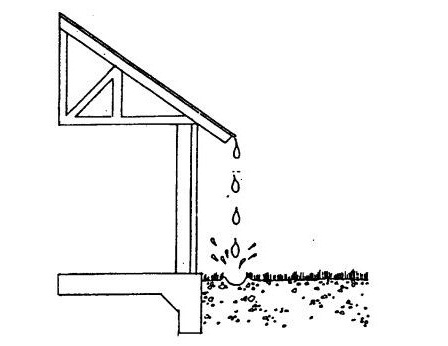 Erosion along the gutter drip line, at the end of downspouts or near outside walls »
Erosion along the gutter drip line, at the end of downspouts or near outside walls »
- Inspect and maintain gutters
- Protect the pipe outlet with a splashguard or stone
- Reroute the discharge point using downspout extensions
- Protect the drip line with gravel or vegetation
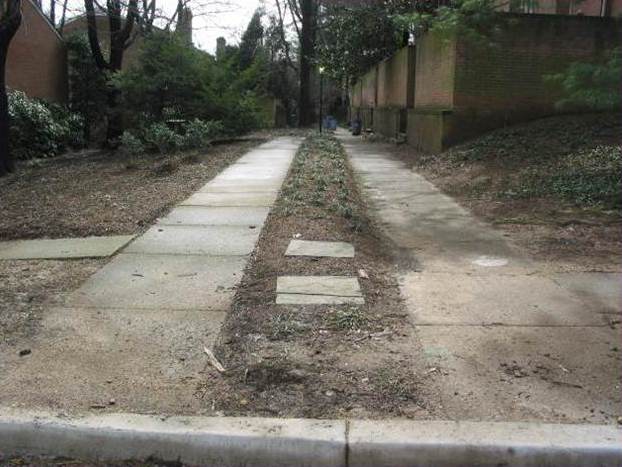 Sediment deposited on sidewalks, driveways or flat areas »
Sediment deposited on sidewalks, driveways or flat areas »
- Find the source of sediment, protect the eroding area
- Redirect or capture runoff
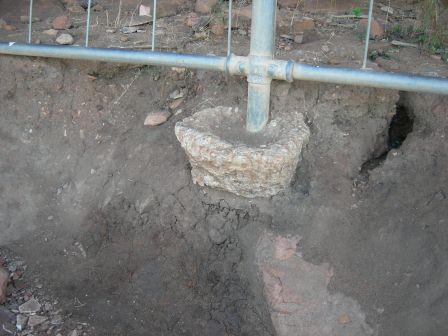 Erosion around an obstruction in the natural path of stormwater flow (scouring) »
Erosion around an obstruction in the natural path of stormwater flow (scouring) »
- Remove or cut obstruction, fill depression
- Less preferred: Protect the eroding area with stone or riprap

